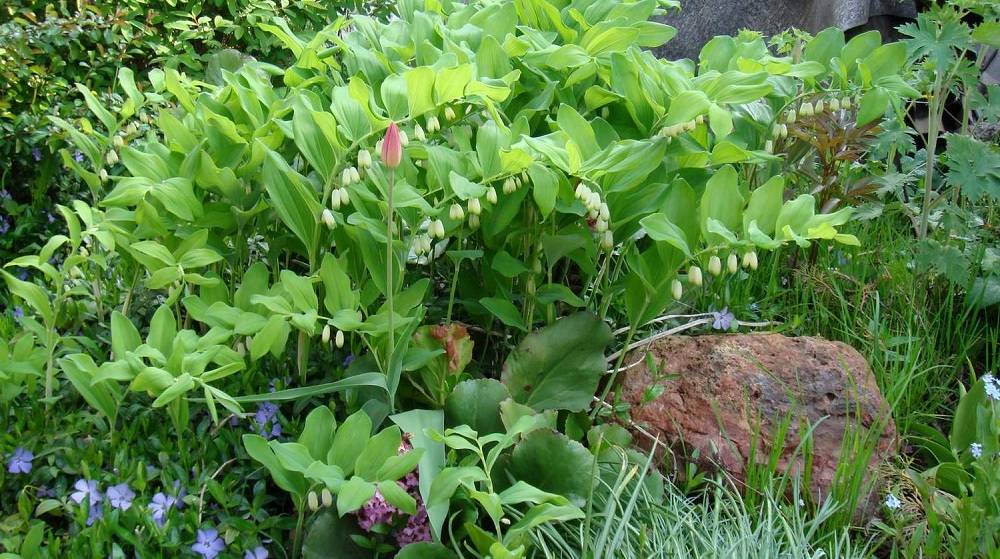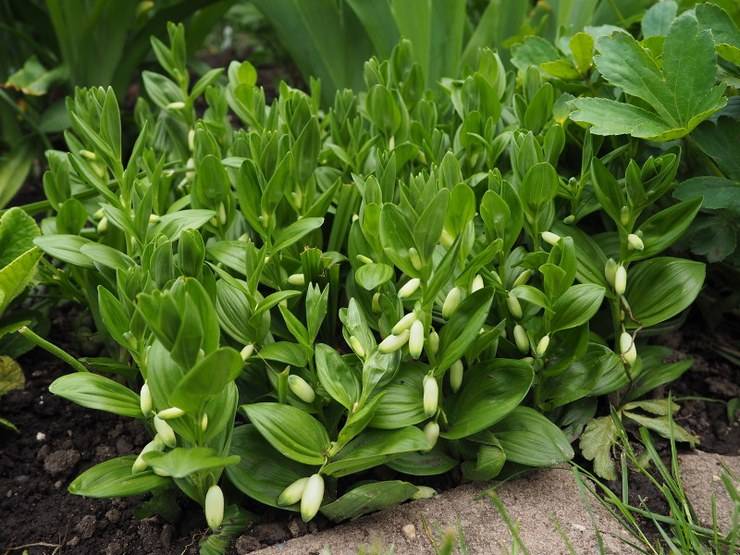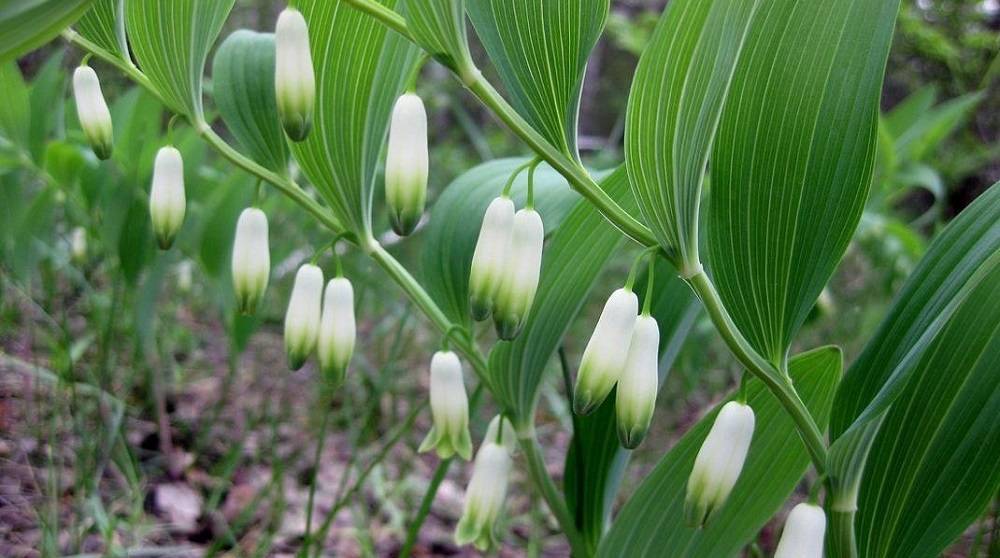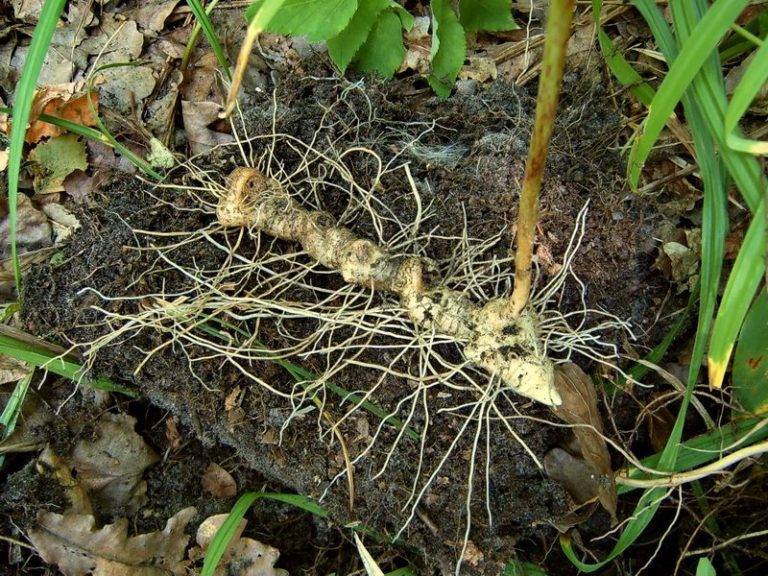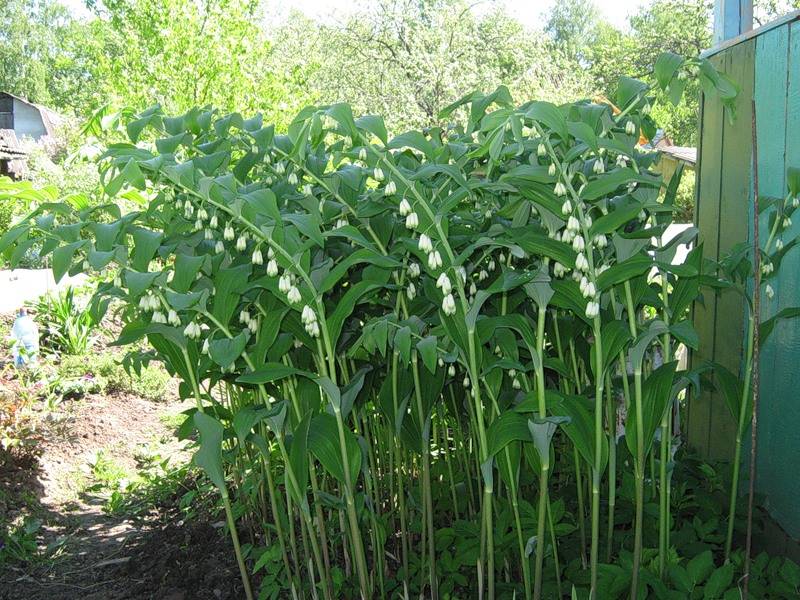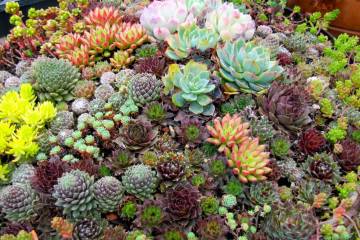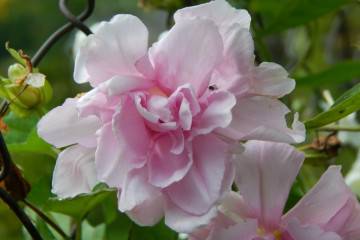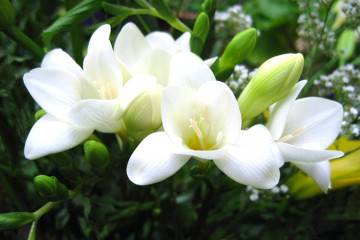Kupena multi-flowered - planting and care in the garden
Content:
The unpretentious beauty Kupena is a perennial with an exquisitely sophisticated look. Decorative foliage, gracefully curved stem and touching fragrant drooping bell flowers will not leave anyone indifferent.
Kupena multi-flowered or garden lily of the valley
Kupena multiflorum (Polugonatum multiflorum) of the Asparagus family is a perennial flowering herb, a close relative of May lily of the valley. Previously, the kupena belonged to the Lily of the Valley family, which has now been abolished. Translated from Latin, the name of the perennial consists of two words "many" and "knee", which indicates the shape and size of the rhizome.
The origin and appearance of the plant
In the wild, the flower is ubiquitous in Northern and Southern Europe. It grows in forest glades of coniferous and deciduous massifs, preferring shady, semi-shady places.
Kupena is a perennial 50-90 cm high, has a bare stem, curved by a yoke, elliptical smooth leaves. The inflorescences are bisexual, collected in small groups in the leaf axils. Kupena flowers are small drooping snow-white bells with green teeth along the edge and with a delicate aroma. The flowering period is about five weeks in May-June. The fruit is a black-purple berry.
The rhizome grows in a horizontal direction, lignifies over time, becomes multi-generational. Roots and buds overwinter in the ground, foliage dies off in autumn. In early spring, new stems grow from the buds at the ends of the root. On the rhizome, traces of dead stems at the end of each season are clearly visible, which helps to determine the age of the plant.
Combination with other plants
Thanks to its beautiful foliage and touching bell flowers, the perennial goes well with brightly flowering plants. Spring primroses - crocuses, scillas, primroses and daffodils and tulips blooming a little later - look beautiful against the background of the lush greenery of the bush. In the summer, the kupena successfully masks the withered foliage of spring bulbs.
After the flowering period, the multiflorous one does not lose its decorative effect. Its curved stems create interesting compositions with daylilies, astilbe, irises and other perennial flowers. The bush is well adjacent to plants that prefer partial shade - ferns, hosts, dicentra, hellebores.
Kupena in landscape design
Due to its shade tolerance and unpretentiousness, the kupena is an indispensable element in landscape design. The plant is used to mask problem areas in the shade. Often the shrub is used to create picturesque clumps in the trunk circles of garden trees and shrubs.
Kupena looks impressive against the background of large stones and wooden compositions. The plant is planted to frame decorative ponds in combination with forest geraniums, iris-iris and primroses.
Why is this flower dangerous?
All parts of the plant, especially the fruit, contain plant alkaloids.Kupena is considered a poisonous plant. Careless eating can cause vomiting and hallucinations. Juice with careless external application can cause burns.
Popular types of kupena for growing in the garden
In cultural floriculture, the most common types of garden lily of the valley are:
- Kupena medicinal (Polugonatum odoratum) - perennial 30-70 cm tall.
- Crescent kupena (Polugonatum falcatum) - perennial up to 80 cm, leafy plates with a small edge.
- Broadleaf Kupena (Polugonatum hirtum) is a 0.5 m high plant with wide leaf blades. It blooms in May-June with greenish flowers.
- Whorled Kupena (Polugonatum verticillatum) is distinguished by narrow elongated leaves forming whorls at the top of the stem. Blooms later than other species - in June-July.
- Kupena is squat, low - a miniature plant not exceeding 15-35 cm in height. The leaves are arranged horizontally. It blooms with white bells with a pinkish tinge.
- Hooker's Kupena (Polugonatum hookeri) is a squat bush up to 10 cm tall with narrow lanceolate leaves. The flowers are pink with a purple tint.
- Kupena Pratti (Polugonatum Pratti) is distinguished by purple bells gathered in panicles.
Medicinal purchase
Kupena medicinal (pharmacy) is a herbaceous plant 30-70 cm tall. It has a naked, knotty, slightly tilted stem. The leaves are oblong ovoid, blue-green in color. They are located alternately, with one side facing the stem. It blooms in May with tubular bells of white or greenish color, located in the axils of leaves, 1-2 pieces.
Useful properties of medicinal
The sap of the plant has a complex chemical formula. Contains alkaloid glycodine, cardiac glycosides, steroid saponins. Has a hemostatic, anti-inflammatory, antipyretic, enveloping effect. For medicinal purposes, rhizomes, fruits and fresh grass are used.
In folk medicine, a medicinal plant in the form of infusions and decoctions is used to treat rheumatism, diabetes mellitus, stomach ulcers and gastritis. It is used to reduce symptoms in acute bronchitis, pneumonia. The extract from the fruit treats diseases of the cardiovascular system. The herb juice is used to heal wounds, abscesses, skin inflammations. It is used as compresses for arthritis, radiculitis, lumbago.
Treatment with drugs based on garden lily of the valley is contraindicated in case of individual intolerance, pregnancy, in childhood.
Fragrant Kupena
In appearance, it is similar to the medicinal kupena. The main difference is that the pedicels and bases of the leaves are colored crimson red. A perennial plant reaches a height of 80 cm. It blooms in May with drooping bells of white-green color. Kupena fragrant moisture-loving, grows well on moist soils.
Kupena: planting and care in the open field
The flower is distinguished by its endurance and unpretentiousness. Even a novice gardener can grow it. The few requirements of the culture are soil moisture without stagnant water and shading of the growing area.
Features of growing from seeds
Seed reproduction is a long and laborious process. It is rarely used and only when you need to get a large number of young seedlings. The seeds are purchased in specialized stores. Planting material can be obtained independently from fully ripe berries.
Step-by-step instructions for seed propagation:
- The seeds are removed from the berries, washed from the pulp.
- Placed in a stratification refrigerator for 1 month.
- Seeds are sown in a sand-peat mixture. The crops are kept in a cool place (+5 degrees) for 3 months.
- For several days it is kept at a temperature of + 22-25.
- Placed in a cool place for another 2 months.
- The container with crops is placed in a place with diffused sunlight at a temperature of + 20-23.
- The sprouts that appear are regularly sprayed, maintaining constant soil moisture.
The seedlings grow slowly during the first months. Young plants are planted in a permanent place in open ground in late autumn, mulch for the winter.
When and how to plant the rhizome in open ground
Perennial reproduces well by dividing the rhizome. This method also provides an additional function - plant rejuvenation, which must be carried out every 4-5 years.
Garden lily of the valley loves shady places with soil rich in humus, although it can grow on poor soils. The plant should not be planted in places where water stagnates. Soils with a close occurrence of groundwater can cause the death of perennials. Before planting, a plot of land is cleared of weeds, dug up with the addition of wood ash and humus. At the bottom of the planting pit, drainage is laid from broken brick, crushed stone or pebbles with a layer of 15 cm.
The best time for planting is August-September. The bush is dug out of the ground, freed from the soil. With a disinfected sharp knife, the rhizome is cut into several parts. Each division must have a root system, a bud, and part of a stem.
The rhizome is laid horizontally, deepening by 8-10 cm. The minimum distance between plants is 20 cm. The plantings are carefully tamped, watered abundantly along the edge of the hole so that the rhizome is not on the surface of the soil. The first two years the shrub grows slowly, then begins to actively grow in width and bloom annually.
Having bought a perennial seedling in a store, a piece of rhizome with a bud is planted in early May in a pre-prepared planting pit to a depth of 7-8 cm.
Watering mode
The plant is hygrophilous, but it will develop well and bloom, being content with the amount of moisture from precipitation. A perennial is watered during a drought with a significant drying out of the soil cover. Excessive dampness and stagnant water can lead to the development of fungal diseases.
Top dressing
Perennial is able to grow on marginal soils, but prefers lands rich in organic matter. The bush needs additional fertilizing with complex mineral fertilizer twice a year: during the budding period and after flowering. On poor soils, additional application of organic fertilizers is recommended.
Features of care during flowering
The plant forms buds in early May in the form of hanging closed bells. The flowering period lasts about five weeks. During this period, the bush especially needs phosphorus and potassium. Useful elements are introduced in the form of a solution, combined with watering.
Features of care during the rest period
The plant can suffer from weeds in the early years of growth. Mature bushes form a dense clump, inhibiting the growth of any weeds. Loosening of the soil around the perennial must be carried out with great care - the roots of the kupena are located shallowly, they are easy to damage. It is better to care for the garden lily of the valley, replacing loosening with mulching.
When planting a perennial in flower beds, the growth of the plant should be limited. With its high growth potential, the shrub inhibits the development of other flowers growing nearby. Kupena can grow in one place for up to 15 years, if the increase in the length of the rhizomes does not interfere with other plantings. The plant grows in the form of a dense carpet, can occupy large areas.When growing crops in compositions with other flowers, once every 3-5 years, the perennial should be dug up and divided.
Preparing for winter
The plant winters well without shelter. The aboveground part dies off in autumn, the rhizome endures wintering in the soil. If frosty weather without snow cover is expected, plantings are mulched with a mixture of peat with sand or compost. In regions with severe frosts, the bushes are protected by spruce branches, leaf litter, sawdust.
Possible pests and diseases when caring for a bath
Perennial has high immunity against many diseases. In rainy years, the leaves can be affected by powdery mildew and gray mold. The damaged parts of the plant are removed, the bush is treated with a fungicide.
The succulent foliage of the kupena garden flower attracts various leaf-eating pests: caterpillars and insect larvae. In rainy years, slugs bring a lot of trouble. Insects-parasites are fought with folk remedies with a deterrent effect or the plant is sprayed with a contact insecticide. The drug "Metaldehyde" helps well with slugs.
Very rarely, a culture is affected by nematodes. Fighting worms is useless. The plant is destroyed, the soil is disinfected with Karbofos.
The kupena, unpretentious in planting and leaving, deserves the attention of flower growers. Its ability to mask unsightly parts of hedges, fill shady corners of the garden, displacing weeds, make the plant an indispensable element of landscape design.

